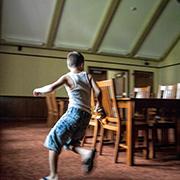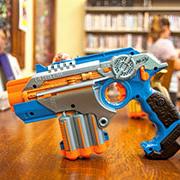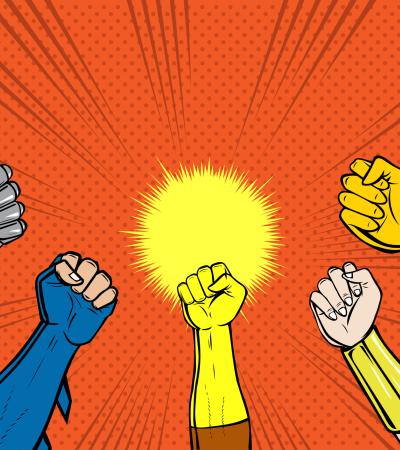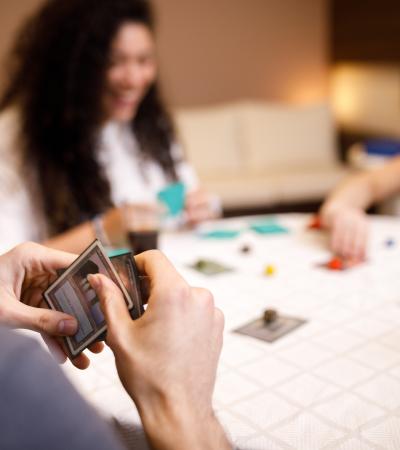Teens and tweens are invited to the library during its closed hours to play team laser tag. They are divided into two teams and take turns using laser phasers (purchased from Amazon) to play the game.
The library lights are dimmed, and the teens and tweens have free reign of the library and can play in any part of the building, except for the young adult room. This room is designated as a “safe zone” where kids can reload their phasers if they have lost all of their lives or need to rest.
Advanced Planning
The goal for this program was to bring teens and tweens into the library and to create a sense of community for the teens. Participants have made new friends and spend time together outside of the library. The young adult librarian, young adult intern and library director worked together to plan this program after it was suggested by members of our teen advisory board.
Special care was taken to ensure the program didn’t feel violent. This included the choice of sci-fi inspired phasers, which use light to hit a target located on an opponent’s phaser, instead of traditional laser guns. The librarians also selected phasers that were intended for team play, rather than individual play, so teens would be encouraged to work together and get to know one another.
Marketing
The program was tested by the members of the teen advisory board, who used word of mouth to market the program to their friends. The library also used traditional marketing methods for the program, which include posters in the library and other prominent locations in town, press releases to newsletters, advertisement on the library’s website and Facebook page, and outreach to the local middle school and high schools.
Budgeting
The cost for this program is relatively minimal. We purchased a set of two phasers from Amazon for $64. Our library has an Amazon Prime membership, so we did not have to pay for shipping. As a small library, we opted to purchase four sets of two phasers (eight total), allowing teens to take turns playing the game. This gives teens the chance to socialize in the library and encourage other participants while they wait. This is the only equipment needed to play the game, and the phasers we purchased are sturdy enough that they have not needed replacement in the 2 ½ years we have been hosting the program.
The only other costs for this program are staffing and batteries for the phasers. The young adult librarian hosts this program on her own, so she is paid for 1-½ hours for each program (one hour for the program, plus 15 minutes to open the library and 15 minutes to close the library). The phasers generally need their batteries changed after three or four programs.
Day-of-event Activity
There is little to no set-up for this program. The young adult librarian scans the library to ensure chairs, step stools and other tripping hazards are moved out of the way before the program begins and hands out the phasers. Simple as that!
The only challenge the librarian has faced is learning how to host the program in a way that does not condone violence or bring up disagreements. We always begin the program by encouraging teens to play as a team and to retreat to the safe zone if they need to reload their phaser or take a break.
Program Execution
This program has been popular enough that we have made it a monthly program (with a break during our summer reading program). The first few times we have hosted this program we have had 20 teens and tweens attend. Since then attendancehas varied, but averages about 10 teens per program. This may not sound like a lot, but as a small, rural library, these are great numbers for teen/tween programs for us.
We turn most of the lights off in the library to make the experience more fun for the teens, and they really get active running around and shouting. It is wonderful to see teens break away from the concept of a library as a quiet place and embrace the concept that the library can be a space where they can have fun, socialize and develop team-building skills. Parents enjoy the program, too, because it is a great way for teens to get a little exercise during the colder winter months, and they enjoy seeing them have fun with new friends.
This program does not have a formal evaluation component. The young adult librarian reports to the director after each program to discuss attendance and how she feels it went. There have been times when attendance has been low and the librarians have decided to take a break for a few months to regain interest. The librarians speak to parents during and after the program to gain their input, and the teens are never shy to share their opinions about the program, either.
There was one incident where a library patron and parent (whose child was not involved in the program) learned about the program and complained that it was inappropriate for a library setting and that the library should not encourage teens to engage in “gun play.” At this time, the library director and board of trustees evaluated the program in detail in order to decide whether or not to continue hosting the program. The positive aspects of the program, such as a space for teens to socialize, physical activity, team-building and the good natured way the teens engage in the game, ended up outweighing the negative connotation that laser tag is ultimately violent. The board of trustees ruled that as long as teens continue to engage in the program in a respectful and non-violent way, the library will continue to host the program.
Advice
Be sure to have a plan in place in case a parent or other community member complains about the program. Our complaint was initially made via a Facebook post blasting the library for promoting violence. The library director, who handles the library’s social media accounts, immediately responded to the complaint providing more details about the program and the positive aspects.
The director also invited the complaining patron to a private meeting to discuss the program. During this meeting the director provided details about the origin of the program, how it is played out and why we feel it is appropriate. The patron still disagreed, and was encouraged to bring her concerns to the attention of the board of library trustees. The patron was not able to attend the next trustee’s meeting in person, but did submit a letter, which was read and discussed by the board.
Supporting Materials
- Feedback (Coming Soon!)
- Programming Librarian Facebook Group






